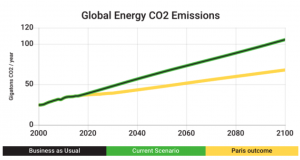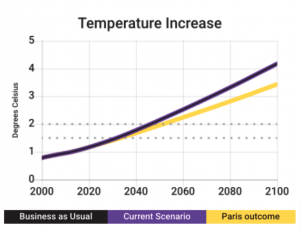23. Climate / Development Pathways
Key questions for this investigation
- What human activities influence the earth’s carbon balance?
- What would it take to keep the 2100 increase in mean global temperature to below 2.0°C above preindustrial levels?
To investigate these questions you will be running three major development scenarios to determine how carbon emission and sequestration rates will likely impact average global temperature for the year 2100. You will also be examining the probable environmental impacts associated with projected temperature increases.
Tool used for this investigation
- C-ROADS < https://croadsworldclimate.climateinteractive.org > from Climate Interactive.
Background
C-ROADS is a major component of the World Climate Simulation (WCS) developed by Climate Interactive < www.climateinteractive.org >. WCS is a role-playing exercise for groups meant to acquaint students, community groups, and others with the purpose and mechanics of UN climate negotiations. In this process C-ROADS serves as a tool for analyzing the outcome of proposals put forth in mock negotiations.
Despite being designed to be a central component of the WCS, C-ROADS can be used separately from the negotiations exercise, as you will be doing in the following activities. In brief, the model enables you to set carbon emission and sequestration rates for global society or regions of it to see what impact these rates and their timing have over mean average global temperature until the end of the 21st century. The model also computes and displays the impact of these rates on sea level, ocean acidification, and greenhouse gas concentrations. The carbon emissions you set in the simulator are largely carbon dioxide related to energy production, while adjusting sequestration includes decreasing the destruction of forest lands (deforestation) and the replace of forested through planting (afforestation).
Investigation
Activity A: Business as usual scenario
Begin by launching C-ROADS in your web browser < www.climateinteractive.org >. Figure 1 shows what you will first see when C-ROADS has finished launching.
 |
Figure 1 – The default screen for C-ROADS: Most of the controls for the simulator are in the upper left corner of the screen. Additional controls include the table in the lower right that controls the timing and rate of emission reductions, deforestation, and afforestation. The graph on the left shows CO2 emissions per year from 2000 to 2100 and the resulting increase in MGT (mean global temperature) for the same time period.Note: C-ROADS does not work on browsers on mobile devices, so you will need to use either a laptop or a desktop computer to run it. |
By default, C-ROADS begins with a “Business as usual” scenario or BAU. To understand what this means consider that approximately 85% of the energy consumed by global society comes from burning fossil fuels. Also consider that global fossil fuel consumption has risen from 29,138 Twh in 1950 to 113,845 Twh in 2017. Under the BAU scenario, fossil fuels remain as the world’s dominant energy source with production and consumption continuing to increase at a similar or even faster rate than they did between 1950 and 2017. The goal of this activity is to become familiar with C-Roads and examine the climate impact of continuing with along the BAU pathway.
To begin, select “Global” from the drop down “Simulation” menu in the upper left corner of the screen. Once you do this you will see the graph on left change so it looks like figure 2. The graph on the right should remain unchanged.
 |
Figure 2: Projected Global CO2 emissions from burning fossil fuels (left graph) and temperature increase above the pre-industrial average (right graph) from 2000 to 2100 under “Business as Usual” conditions. Move the cursor over the green or purple plot lines to read values for either emissions or temperature increase for specific years. |
Questions – Business as Usual
- What were the total emissions in the year 2000? What are they expected to be in 2020 and again in 2100?
- What is the expected temperature increase in 2100?
- What was the atmospheric CO2 concentration in 2000? What is it expected to be in 2020 and again in 2100?
- To answer this go to the “Graphs” menu in the upper right and select “CO2 concentration” from the menu that appears when you scroll over “Impacts”.
- What is the expected rise in sea level in 2020 and again in 2100?
- This is sea level rise relative to 2000. To find this go the “Graphs” menu and select “Sea level rise” from the menu that appears when you scroll over “Impacts”.
Activity B: Paris commitment
The 2019 version of C-ROADS contained a preset scenario titled the “Paris Outcomes”. This scenario showed global temperature increase based on the carbon reduction and sequestration commitments that signatories to 2015 Paris climate agreement brought to that international conference (Nationally Determined Contributions or NDCs). For reasons explained on the Climate Scoreboard: UN Climate Pledge Analysis this scenario was deleted from the 2020 release of the program. While the developers reasons for making this change are understandable it makes it difficult to investigate the gap between NDCs and the agreed upon 2100 global temperature increase of 1.5 to 2.0°C. For that reason, figure 3 contains screenshots of global CO2 emissions and temperature increase from the 2019 version of C-Roads. To answer the following questions you can use Figure 3 and the Climate Scoreboard.
 |
 |
Figure 3: Projected Global CO2 emissions and temperature increase for both the BAU and Paris Outcomes (yellow line) scenarios. You may have to go to the “Graphs” menu to select “Temperature Increase” from the “Impacts” sub menu to change the right graph to show temperature increase. |
Questions – Paris 2015 Committments
- For the Paris Outcomes what are the expected emissions in 2100?
- For the Paris Outcomes, what are the expected atmospheric CO2 concentration, sea level, and ocean acidification in 2100?
- How do all these values compare to the 2100 values from the BAU scenario?
- How far above the temperature increase target set by the 2015 Paris climate agreement is the temperature increase resulting from the current reduction commitments?
The two dotted lines on the temperature increase graph represent the long-term commitment made in the 2015 agreement.
Activity C: Accelerated commitments
For this last activity you are going to experiment with what it would take to keep the 2100 MGT to between 1.5°C and 2.0°C above the pre-industrial MGT. You will be doing this by adjusting the timing and rate of emission reductions, deforestation, and afforestation.
- Emission reductions – Decreasing greenhouse gas emissions from energy production, manufacturing, agriculture, and other technological activities.
- Deforestation – Clearing forest for lumber and the creation of land for agriculture and other development. In short removing trees that would otherwise sequester carbon.
- Afforestation – Replanting cleared land in forest to provide a mean of carbon sequestration.
To begin make sure that your graphs look like figure 3. This may require selecting “Global” and “Reset” from the “Simulation menu”, “Show Paris Outcomes” from the “View” menu, and “Temperature Increase” from the “Impacts” submenu of the “Graphs” menu.
Once your screen is set up, go to the table under the emissions graph (figure 4) and click on the 2100 in the “Emissions Peak Year box. Change that value to 2060.
 |
Figure 4: Controller for the timing and rate of emission reductions, deforestation, and afforestation. |
Questions – Accelerated commitment
- What happens to the Global Energy CO2 Emissions (the green line) and 2100 temperature increase (purple line) when you set the Emissions Peak Year to 2060? Make sure to use numbers when you answer this.
- What happens to the 2100 global emissions and temperature increase when you also set the Reductions Begin Year for 2060 and the Annual Reduction Rate to 5%?
- What would it take to create each of the following scenarios?
- The Temperature increase never goes above 2.0°C.
- The temperature increase never goes above 1.5°C.
- The temperature increase goes above 2.0°C but falls to 1.5°C by 2100.
For each scenario record the Emissions Peak Year, Reductions Begin Year, the Annual Reduction Rate, Prevent Deforestation, and Promote Afforestation necessary to achieve the goal. Make a table for this.
Activity D: Mock Global Climate Summit
C-ROADS was designed by Climate Interactive as a part of the World Climate Simulation, an activity where groups of people play the role of UN climate negotiators working to create an agreement limiting global climate change. The page describing the simulation also provides links to material supporting the simulation.

